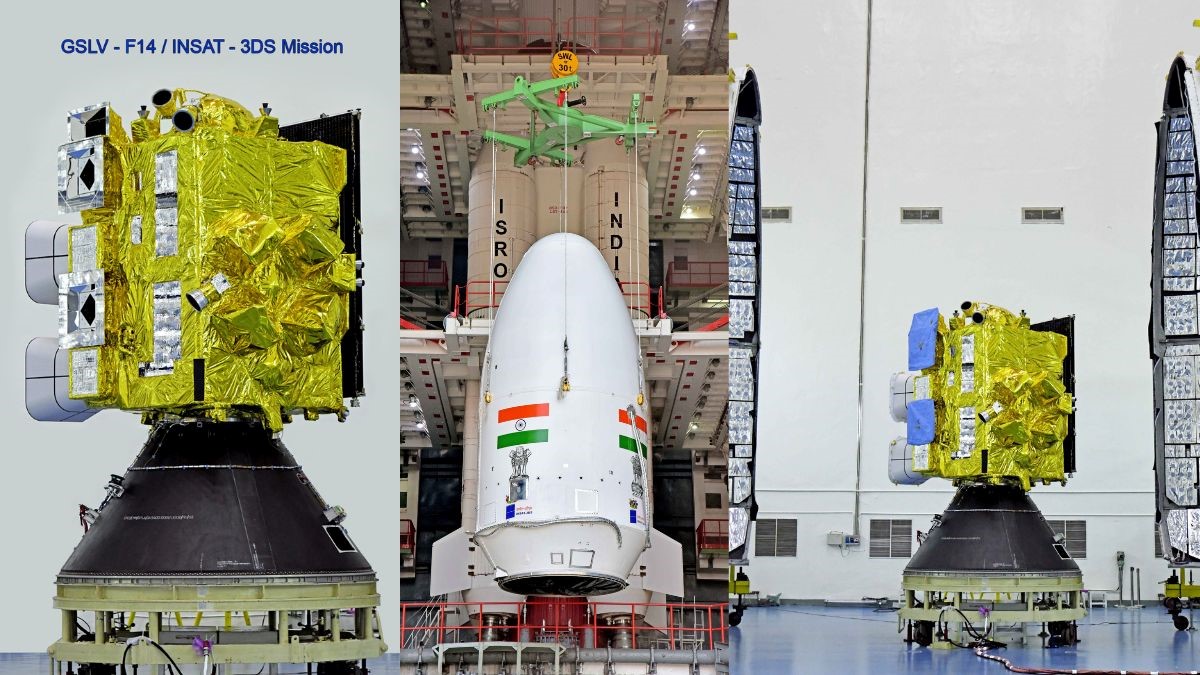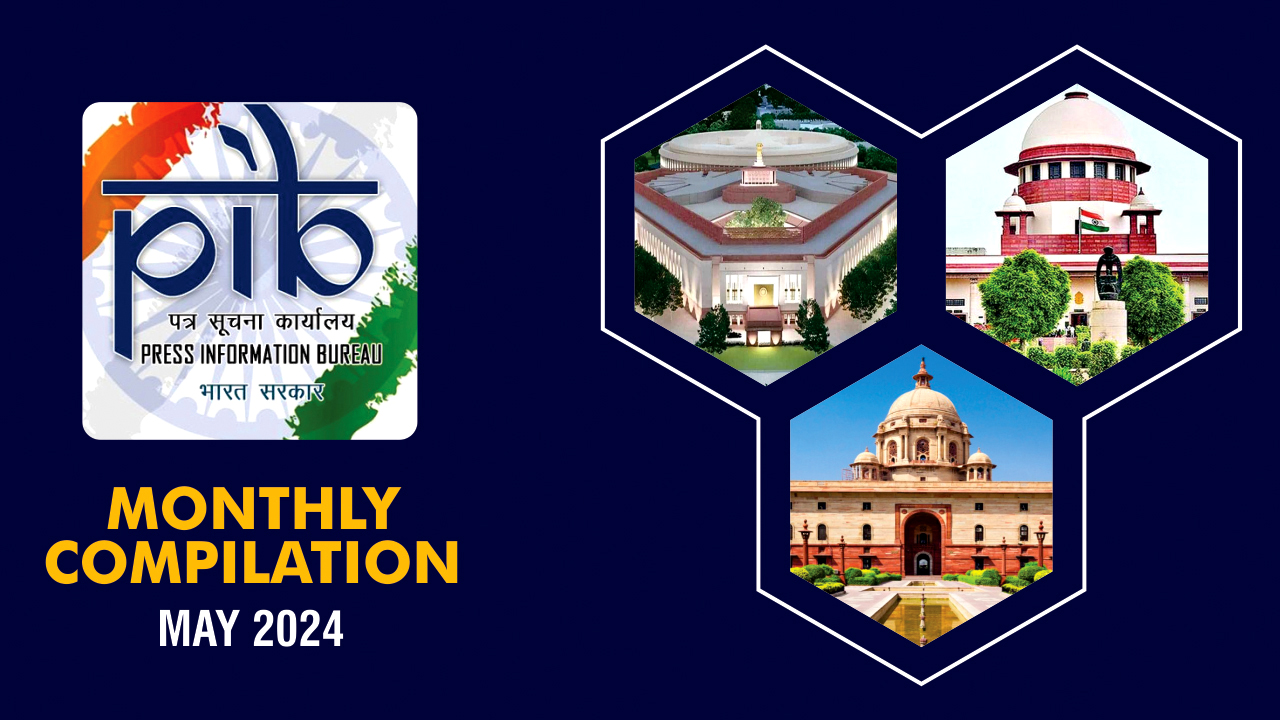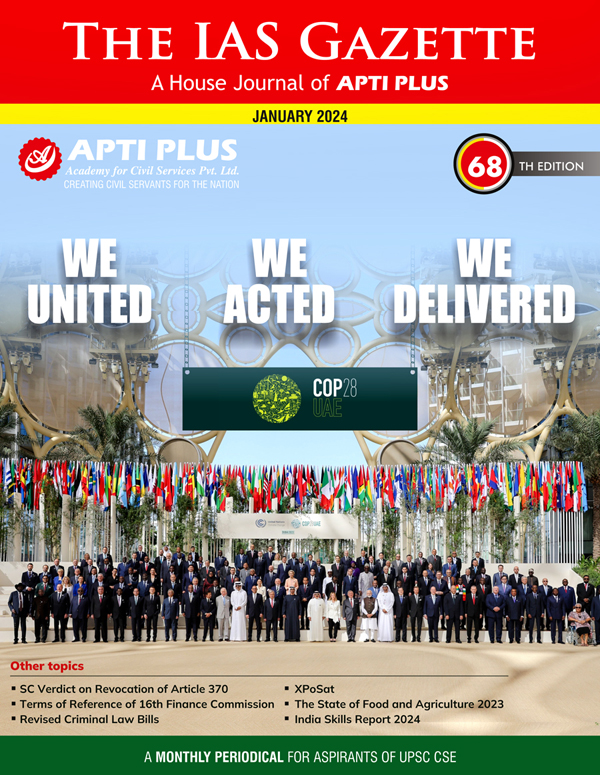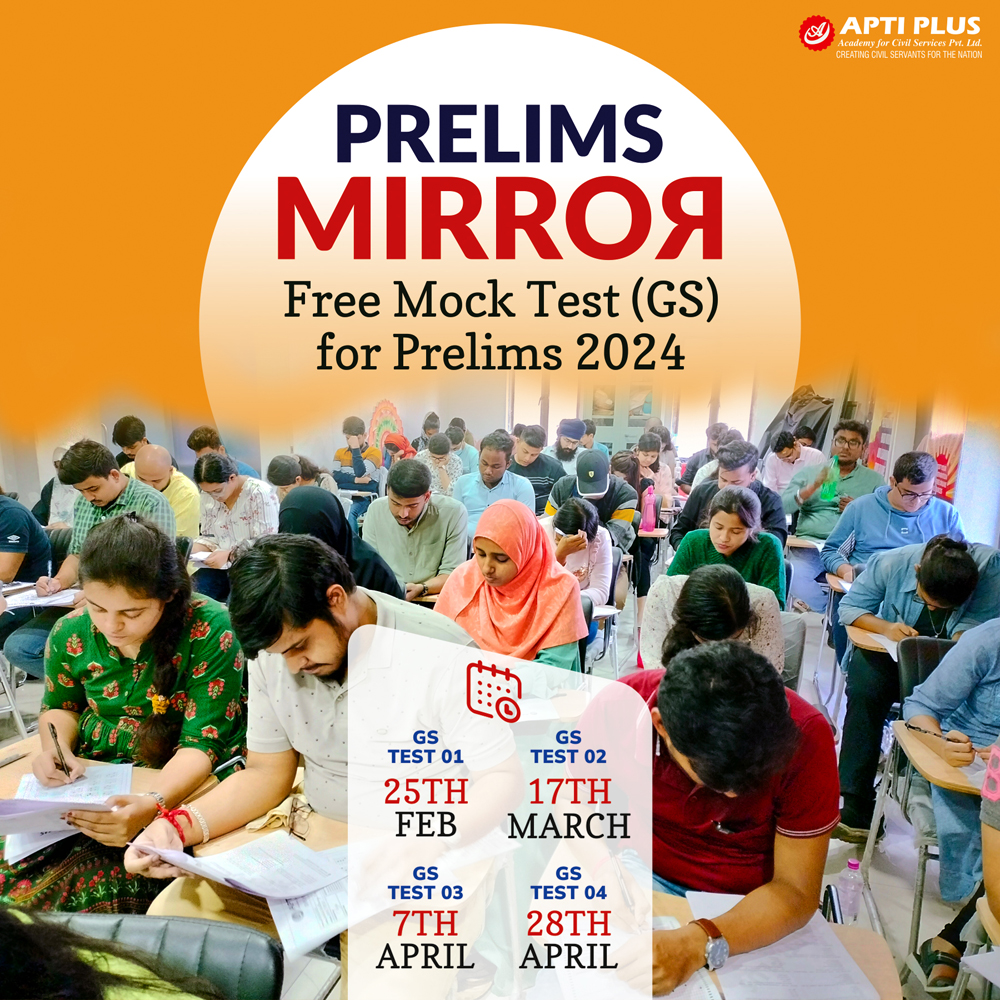
Disclaimer: Copyright infringement not intended.
Context
Satellite INSAT-3DS on launch vehicle GSLV-F14, fully funded by the Ministry of Earth Sciences (MoES), was successfully launched by the Indian Space Research Organisation (ISRO) from the Satish Dhawan Space Centre in Sriharikota, Andhra Pradesh.
Details
Objective
- INSAT-3DS aims to enhance India's meteorological services, complementing the existing INSAT-3D and INSAT-3DR satellites.
- It will improve monitoring of Earth's surface, atmosphere, oceans, and environment, thereby enhancing data collection, dissemination, and satellite-aided search and rescue services.
- The initiative will advance weather, climate, and ocean-related observations and services in India, contributing to disaster mitigation and preparedness.
Satellite Specifications
- INSAT-3DS is based on ISRO's I-2k bus platform and has a lift-off mass of 2,275 kilograms.
- Equipped with state-of-the-art payloads, including:
- An imager payload with a six-channel optical radiometer for Earth imaging.
- A 19-channel sounder payload for atmospheric information.
- Communication payloads, including a data relay transponder and a satellite-aided search and rescue transponder.
- Indian industries have played a significant role in the development of INSAT-3DS.
Utilization of Meteorological Data
- Meteorological data from INSAT-3DS will be utilized by various institutes under the Ministry of Earth Sciences (MoES), such as the India Meteorology Department (IMD), National Centre for Medium-Range Weather Forecasting (NCMRWF), Indian Institute of Tropical Meteorology (IITM), National Institute of Ocean Technology (NIOT), and Indian National Centre for Ocean Information Services (INCOIS).
- This data will enhance meteorological research and services, improving weather and climate prediction, timely alerts, early warnings, and advisories for the public, including last-mile users such as fisherfolk and farmers.
GSLV Rocket: Understanding the "Naughty Boy"
- The GSLV (Geosynchronous Satellite Launch Vehicle) is a rocket developed by the Indian Space Research Organisation (ISRO) for launching satellites into geostationary transfer orbits.
- Despite its capabilities, the GSLV has gained the nickname "naughty boy" due to its inconsistent track record, characterized by several failed launches.
Cryogenic Engines and Challenges
- The GSLV employs cryogenic engines, fueled by a combination of liquid hydrogen and liquid oxygen, in its upper stage.
- Cryogenic engines offer greater thrust and efficiency compared to traditional engines but pose technical and operational challenges due to their complexity.
- Issues with cryogenic technology have been a significant factor contributing to the GSLV's failures.
Launch Failures and Contributing Factors
- At least four out of 15 previous GSLV launches have ended in failure, highlighting the rocket's reliability challenges.
- Examples of failures, such as the GSLV-F10 mission in August 2021 carrying the EOS-03 satellite, showcase instances where the cryogenic engine failed to ignite during the critical upper stage.
- Malfunctions in the electronics of the cryogenic engine have been identified in failure analyses, indicating technical deficiencies that need addressing.
Historical Context and Development
- The GSLV program has undergone phases of indigenous and collaborative development, including the adoption of Russian cryogenic engine technology.
- Early failures, such as the GSLV-D3 mission in April 2010, demonstrated the initial challenges in mastering cryogenic technology.
- Transitions between indigenous and Russian cryogenic engines have introduced complexities and uncertainties in the GSLV program.
Response and Future Prospects
- Despite setbacks, ISRO continues to refine and improve the GSLV, leveraging lessons learned from past failures.
- Investments in research and development, along with collaborations with international partners, aim to enhance the reliability and performance of future GSLV missions.
- Recent successful launches, such as the GSLV-F14 mission placing the INSAT-3DS satellite into orbit, demonstrate progress and resilience in ISRO's space exploration efforts.
Overview of Indian Launch Vehicles
India has developed a range of launch vehicles to transport spacecraft into space, catering to various payload sizes and orbital requirements. The key operational launch vehicles are:
- Polar Satellite Launch Vehicle (PSLV):
- PSLV is highly versatile, offering multiple configurations including variants with 6, 4, or 2 solid rocket strap-on motors, as well as core-alone versions.
- It boasts the highest success rate among ISRO's launch vehicles and is often referred to as the workhorse of ISRO.
- PSLV has been utilized for launching Earth observation, geostationary, and navigation satellites.
- Geosynchronous Satellite Launch Vehicle (GSLV):
- GSLV features an indigenous Cryogenic Upper Stage, enabling it to launch communication satellites weighing up to 2 tonnes.
- While GSLV has faced challenges in its development, it has contributed significantly to India's space capabilities.
- Geosynchronous Satellite Launch Vehicle Mk-III (LVM3):
- LVM3 represents the next generation of Indian launch vehicles, capable of carrying 4-tonne class communication satellites and payloads of up to 10 tonnes to Low Earth Orbits (LEO).
- Developed with entirely indigenous technologies, including the C25 cryo stage, LVM3 has achieved a flawless record of successful launches from its maiden flight.
- LVM3 is designated as the launch vehicle for ISRO's ambitious Gaganyaan mission, India's first manned spaceflight program.
- Small Satellite Launch Vehicle (SSLV):
- SSLV is under development, aimed at meeting the growing demand for launching small satellites.
- It will utilize indigenous technologies to provide cost-effective and flexible access to space for small satellite missions.
Launch Vehicle Development Centers:
- Vikram Sarabhai Space Centre (VSSC): Responsible for the design and development of launch vehicles.
- Liquid Propulsion Systems Centre (LPSC): Develops liquid propulsion systems for launch vehicles.
- ISRO Propulsion Complex (IPRC): Located at Valiamala and Mahendragiri, develops cryogenic stages for launch vehicles.
- Satish Dhawan Space Centre, SHAR: Serves as India's primary spaceport, responsible for the integration of launch vehicles and conducting launches.

Polar Satellite Launch Vehicle (PSLV): India's Reliable Workhorse
- PSLV is India's third-generation launch vehicle, equipped with liquid stages, and emerged as a reliable and versatile asset since its successful debut in October 1994.
- Renowned for its consistency, PSLV has launched numerous Indian and foreign satellites, including notable missions like Chandrayaan-1 (2008) and Mars Orbiter Spacecraft (2013).
Key Achievements:
- Chandrayaan-1 and Mars Orbiter Mission (MOM) are notable successes of PSLV, showcasing its capability to launch missions to the Moon and Mars, respectively.
- PSLV has earned the title 'the workhorse of ISRO' for delivering various satellites into Low Earth Orbits (LEO), including the IRS Series and IRNSS Constellation.
Configuration and Capabilities:
- PSLV offers multiple variants tailored to payload weights and orbit requirements, including PSLV-CA, PSLV-DL, PSLV-QL, and PSLV-XL.
- The PSLV-XL configuration has a gross weight of 320 tonnes, an overall height of 44.4 meters, and a diameter of 2.8 meters.
- It is a four-stage vehicle capable of multiple satellite launches and missions to multiple orbits, showcasing its versatility and mission flexibility.
Technical Specifications:
- First Stage (PS1): Utilizes the S139 solid rocket motor augmented by six solid strap-on boosters (S12) for additional thrust.
- Second Stage (PS2): Features the Vikas engine, an Earth storable liquid rocket engine developed by the Liquid Propulsion Systems Centre.
- Third Stage (PS3): Employs a solid rocket motor (S7) to provide high thrust after the atmospheric phase of the launch.
- Fourth Stage (PS4): Comprises two Earth storable liquid engines (PS-4) for the uppermost stage of the launch.
Payload Capacities:
- PSLV can carry payloads up to 1,750 kg to Sun-Synchronous Polar Orbits (SSPO) and up to 1,425 kg to Sub Geosynchronous Transfer Orbits (Sub GTO).
Geosynchronous Satellite Launch Vehicle Mark II (GSLV Mk II): India's Communication Satellite Launcher
- GSLV Mk II is a launch vehicle developed by India specifically designed to launch communication satellites into geosynchronous transfer orbit (GTO) using a cryogenic third stage.
- Initially, GSLV Mk II used Russian-supplied cryogenic stages, but indigenously developed cryogenic stages were incorporated from GSLV D5 onwards in January 2014.
Key Features:
- GSLV Mk II is classified as a fourth-generation launch vehicle, featuring a three-stage configuration with four liquid strap-on boosters.
- The flight-proven Cryogenic Upper Stage (CUS), developed indigenously, serves as the third stage of GSLV Mk II.
Technical Specifications:
- Height:73 m (With Ogive Payload Fairing)
- Number of Stages: 3
- Lift Off Mass: 420 tonnes
- First Flight: April 18, 2001
- First Flight (With Indigenous Cryo Stage): January 5, 2014
Payload Capacities:
- Payload to GTO: 2,250 kg
- GSLV's primary payloads are communication satellites like INSAT class satellites, which operate from geostationary orbits and are placed in GTO by GSLV.
- Payload to LEO (Low Earth Orbit): 6,000 kg
- GSLV's capability to place up to 6 tonnes in LEO broadens the scope of payloads from heavy satellites to multiple smaller satellites.
Technical Details of Stages:
- Third Stage (CUS):
- Developed under the Cryogenic Upper Stage Project (CUSP), it features the CE-7.5 cryogenic engine, using LOX (Liquid Oxygen) and LH2 (Liquid Hydrogen) as propellants.
- Fuel: LOX + LH2
- Nominal Thrust (Max): 75 kN
- Burn-time: 814 sec
- Second Stage (GS2):
- Utilizes a single Vikas engine derived from PSLV's PS2, proving its reliability.
- Fuel: UH25 + N2O4
- Nominal Thrust (Max): 846 kN
- Burn-time: 150 sec
- First Stage (GS1):
- Derived from PSLV's PS1, featuring a 138-tonne solid rocket motor augmented by four liquid strap-on boosters.
- Fuel: HTPB
- Thrust: 4800 kN
- Burn-time: 100 sec
LVM3: India's Heavy Lift Launch Vehicle
- LVM3, or the Launch Vehicle Mark-III, is India's heavy lift launch vehicle designed to significantly enhance the country's capability to place heavy payloads into space.
- It is a crucial component of India's space program, offering cost-effective access to geosynchronous and low Earth orbits.
Key Features:
- LVM3 is configured as a three-stage vehicle comprising two solid strap-on motors (S200), a liquid core stage (L110), and a high-thrust cryogenic upper stage (C25).
- It features the largest solid boosters in the world, with each S200 solid motor containing 204 tonnes of solid propellant.
Technical Specifications:
- Height:5 m
- Vehicle Diameter:0 m
- Heat Shield Diameter (Payload Fairing):0 m
- Number of Stages: 3
- Lift Off Mass: 640 tonnes
Payload Capacities:
- Payload to GTO: 4,000 kg
- LVM3 is capable of launching 4 tonne class satellites of the GSAT series into Geosynchronous Transfer Orbits (GTO).
- Payload to LEO: 8,000 kg
- Its powerful cryogenic stage enables it to place heavy payloads weighing up to 8,000 kg into Low Earth Orbits (LEO) at an altitude of 600 km.
Technical Details of Stages:
- Cryogenic Upper Stage (C25):
- Powered by the CE-20 engine, India's largest cryogenic engine developed by the Liquid Propulsion Systems Centre.
- Fuel: 28 tonnes of LOX (Liquid Oxygen) + LH2 (Liquid Hydrogen)
- Height:5 m
- Diameter:0 m
- Solid Rocket Boosters (S200):
- Utilizes two S200 solid rocket boosters, developed at the Vikram Sarabhai Space Centre.
- Fuel: 205 tonnes of HTPB (nominal)
- Height: 25 m
- Diameter:2 m
- Core Stage (L110 Liquid Stage):
- Powered by two Vikas engines developed at the Liquid Propulsion Systems Centre.
- Fuel: 115 tonnes of UDMH (Unsymmetrical Dimethylhydrazine) + H2O (Hydrogen Peroxide)
- Height: 21 m
- Diameter: 4 m
Launch Sequence:
- The vehicle takes off with the simultaneous ignition of the two S200 boosters, followed by the ignition of the core stage (L110) during flight.
- The S200 boosters burn for approximately 134 seconds before separation, while the payload fairing separates at about 217 seconds during the L110 firing.
- The L110 burnout, separation, and C25 ignition occur at around 313 seconds, after which the spacecraft is injected into the desired orbit.

Sounding Rockets in the Indian Space Programme
- Sounding rockets play a crucial role in probing the upper atmospheric regions and conducting space research.
- They serve as cost-effective platforms for testing new components or subsystems intended for use in larger launch vehicles and satellites.
Historical Background:
- The launch of the first sounding rocket from Thumba in 1963 marked the beginning of the Indian Space Programme.
- Initially, India relied on imported two-stage rockets from Russia (M-100) and France (Centaure) for sounding rocket missions.
Indigenous Development:
- India started launching indigenously made sounding rockets from 1965, gaining valuable experience in solid propellant technology.
- In 1975, all sounding rocket activities were consolidated under the Rohini Sounding Rocket (RSR) Programme, laying the foundation for India's launch vehicle technology.
Key Contributions:
- The development of indigenous sounding rockets like RH-75, RH-100, and RH-125 was pivotal in mastering solid propellant technology.
- The sounding rocket programme provided the necessary groundwork for the advancement of launch vehicle technology in ISRO.
Operational Sounding Rockets:
- Currently, three versions of operational sounding rockets are offered, covering a payload range of 8-100 kg and an apogee range of 80-475 km.
- RH-200: Payload: 10 kg, Altitude: 80 km, Purpose: Meteorology, Launch Pad: Thumba
- RH-300-Mk-II: Payload: 60 kg, Altitude: 160 km, Purpose: Aeronomy, Launch Pad: SDSC-SHAR
- RH-560-Mk-II: Payload: 100 kg, Altitude: 470 km, Purpose: Aeronomy, Launch Pad: SDSC-SHAR
Satellite Launch Vehicle-3 (SLV-3)
- SLV-3 was India's first experimental satellite launch vehicle, marking a significant milestone in the country's space program.
- It was an all-solid, four-stage vehicle designed to place payloads of up to 40 kg in Low Earth Orbit (LEO).
Key Features:
- Configuration: Four-stage vehicle
- Weight: 17 tonnes
- Height: 22 m
- Payload Capacity: 40 kg to LEO
Launch and Achievements:
- SLV-3 was successfully launched on July 18, 1980, from Sriharikota Range (SHAR), placing the Rohini satellite, RS-1, into orbit.
- This launch made India the sixth member of the exclusive club of space-faring nations.
- SLV-3 employed an open loop guidance system with stored pitch program to steer the vehicle along a pre-determined trajectory.
Subsequent Missions:
- Additional launches of SLV-3 were conducted in May 1981 and April 1983, orbiting Rohini satellites equipped with remote sensing sensors.
- While the first experimental flight in August 1979 was only partially successful, subsequent launches demonstrated the capabilities of the SLV-3.
Augmented Satellite Launch Vehicle (ASLV)
- The ASLV Programme aimed to augment the payload capacity to 150 kg, three times that of SLV-3, for Low Earth Orbits (LEO).
- It served as an intermediate vehicle to demonstrate and validate critical technologies needed for future launch vehicles.
Key Features:
- Configuration: Five-stage, all-solid propellant vehicle
- Weight: 40 tonnes
- Height: 24 m
- Payload Capacity: 150 kg to LEO
Developmental Flights:
- Four developmental flights were conducted under the ASLV programme.
- The first two flights took place on March 24, 1987, and July 13, 1988.
- ASLV-D3 was successfully launched on May 20, 1992, placing SROSS-C (106 kg) into orbit.
- ASLV-D4, launched on May 4, 1994, orbited SROSS-C2 (106 kg) with two payloads, Gamma Ray Burst (GRB) Experiment and Retarding Potentio Analyser (RPA).
Scramjet Engine Test Mission
- ISRO's Scramjet engine utilizes Hydrogen as fuel and Oxygen from the atmospheric air as the oxidizer, showcasing an innovative approach to propulsion systems.
- This test marked the maiden short-duration experimental test of ISRO’s Scramjet engine with a hypersonic flight at Mach 6, highlighting India's technological capabilities in advanced propulsion systems.
- ISRO’s Advanced Technology Vehicle (ATV), an advanced sounding rocket, served as the solid rocket booster for the Scramjet engine test.
- The ATV carrying Scramjet engines weighed 3277 kg at lift-off, demonstrating the versatility and adaptability of existing launch vehicle technologies for experimental missions.
Small Satellite Launch Vehicle (SSLV)
- The Small Satellite Launch Vehicle (SSLV) is a cost-effective and flexible launch system developed by ISRO for launching small satellites into orbit.
- It is designed to provide low-cost access to space for small satellite operators.
Vehicle Configuration:
- Dimensions: 2m in diameter, 34m in length
- Lift Off Mass: Approximately 120 tonnes
- Stages: Three solid propulsion stages and a liquid propulsion-based Velocity Trimming Module (VTM) as the terminal stage.
- Key Features: Low cost, low turnaround time, flexibility in accommodating multiple satellites, launch-on-demand feasibility, minimal launch infrastructure requirements.
Payload Capability:
- Capable of launching:
- Single/multiple satellites including Nano, Micro, and Mini satellites.
- Single satellite up to 500kg in a 500km planar orbit.
- Three multiple satellites ranging from 10kg to 300kg into a 500km Planar Orbit.
Technical Specifications:
- Stage 1: SS1
- Fuel: HTPB based Solid Propellant
- vac Thrust: 2496 kN
- Burn time:3 sec
- Stage 2: SS2
- Fuel: HTPB based Solid Propellant
- vac Thrust: 234.2 kN
- Burn time:1 sec
- Stage 3: SS3
- Fuel: HTPB based Solid Propellant
- vac Thrust: 160 kN
- Burn time:9 sec
- Velocity Trimming Module (VTM)
- Fuel: MMH + MON-3 (Liquid)
- vac Thrust: 50 N x 16
- Description: Utilizes 50N Bipropellant Thrusters with 8 RCS thrusters and 8 axial thrusters for velocity addition.
Reusable Launch Vehicle – Technology Demonstrator (RLV-TD)
- The Reusable Launch Vehicle – Technology Demonstrator (RLV-TD) is a pioneering project by ISRO aimed at developing crucial technologies for a fully reusable launch vehicle, with the ultimate goal of enabling low-cost access to space.
- It represents one of ISRO's most ambitious endeavors, combining the complexities of both launch vehicles and aircraft.
Configuration:
- The RLV-TD is designed in a winged configuration, resembling an aircraft, to serve as a flying test bed for evaluating various technologies.
- Components include a fuselage (body), nose cap, double delta wings, twin vertical tails, and active control surfaces such as Elevons and Rudder.
- The selection of materials, including special alloys, composites, and insulation materials, is critical for the development of the RLV-TD due to the extreme conditions it will encounter during flight.
Objectives:
- Hypersonic Aero Thermodynamic Characterization: Assessing the aerodynamic and thermodynamic behavior of the winged body during hypersonic flight conditions.
- Autonomous Navigation, Guidance, and Control (NGC) Schemes: Evaluating autonomous systems for navigation, guidance, and control to ensure precision in flight trajectories.
- Integrated Flight Management: Testing integrated systems for managing various flight parameters and ensuring smooth operations throughout the flight.
- Thermal Protection System Evaluation: Assessing the effectiveness of thermal protection systems to withstand the intense heat generated during hypersonic re-entry into the Earth's atmosphere.
Technological Challenges:
- Crafting the RLV-TD's components and selecting appropriate materials require advanced manufacturing techniques and highly skilled manpower.
- The vehicle was boosted to Mach 5 by a conventional solid booster (HS9) with a low burn rate, showcasing innovative propulsion solutions.

Human Space Flight Centre (HSFC)
- The Human Space Flight Centre (HSFC) is a pivotal organization within ISRO, tasked with spearheading the Gaganyaan program.
- Its primary objective is to coordinate efforts across various ISRO centers, research labs, academia, and industries to accomplish the mission of human spaceflight. HSFC is committed to upholding high standards of reliability and human safety in all research and development activities related to human spaceflight.
Gaganyaan Mission:
- The Gaganyaan project aims to demonstrate India's capability in human spaceflight by sending a crew of three members to an orbit of 400 km for a 3-day mission, followed by a safe return to Earth, with a landing in the Indian sea waters.
- It involves leveraging in-house expertise, Indian industry experience, academic intellectual capabilities, and cutting-edge technologies available internationally to achieve its goals.
- Critical technologies such as a human-rated launch vehicle, life support systems, crew emergency escape provisions, and crew management aspects are essential prerequisites for the mission's success.
Precursor Missions:
- Various precursor missions are planned to demonstrate the readiness of technology before executing the actual Human Space Flight mission.
- These missions include the Integrated Air Drop Test (IADT), Pad Abort Test (PAT), and Test Vehicle (TV) flights, ensuring the safety and reliability of all systems before the manned mission.
Human Rated LVM3 (HLVM3):
- The well-proven and reliable LVM3 rocket, ISRO's heavy lift launcher, has been designated as the launch vehicle for the Gaganyaan mission.
- HLVM3 is a modified version of LVM3, reconfigured to meet human rating requirements. It consists of solid, liquid, and cryogenic stages.
- HLVM3 includes a Crew Escape System (CES) powered by high burn rate solid motors to ensure crew safety in case of emergencies during launch or ascent phases.
- The Orbital Module (OM), comprising the Crew Module (CM) and Service Module (SM), is equipped with advanced avionics systems and redundancy measures for crew safety.
- The CM provides a habitable space with an Earth-like environment, featuring double-walled construction, life support systems, and deceleration systems for crew safety during descent.
- The SM supports the CM in orbit, containing thermal, propulsion, power, and avionics systems

Conclusion
- The successful launch of INSAT-3DS marks a significant milestone in India's space and meteorological capabilities, highlighting the collaborative efforts between ISRO and MoES.
- The satellite's advanced features and comprehensive payloads are poised to revolutionize meteorological observations and services in India, contributing to better disaster management and societal well-being.
|
PRACTICE QUESTION
Q. With its indigenous cryogenic stage and impressive payload capacities, GSLV Mk II plays a crucial role in launching communication satellites and expanding India's presence in space. Discuss. (250 words)
|











